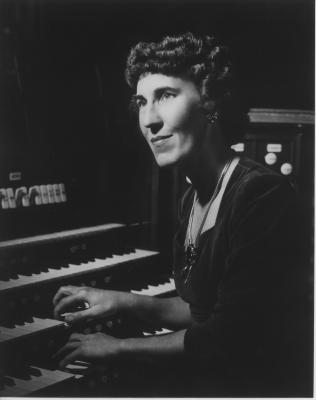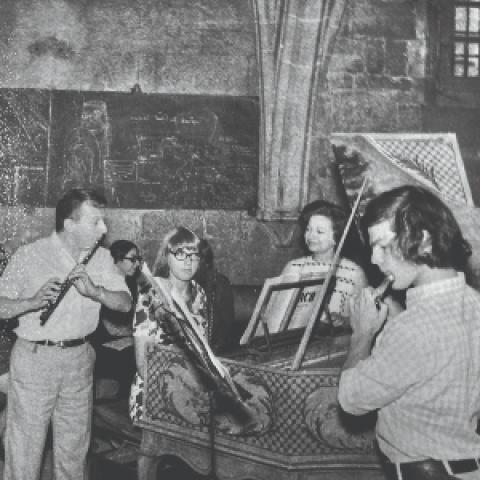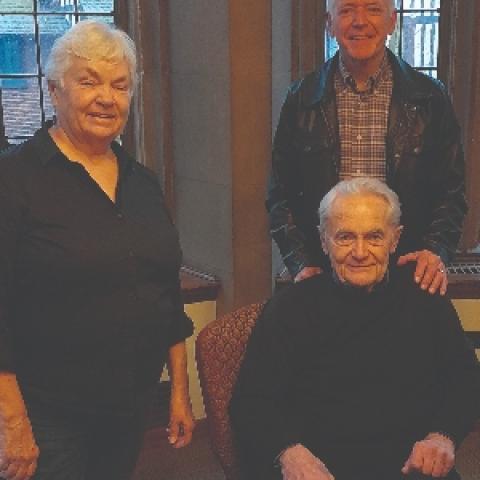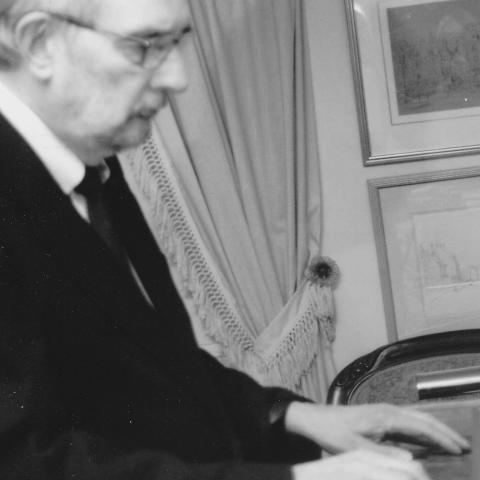Mabel Zehner (photo credit: Ashland University Archives, Ashland, Ohio)

Giving thanks from A to Z, part 2: Moving to Dallas (1970)
During late spring of 1970 I was invited to present my Hugo Distler lecture and a masterclass on his organ music at the University of Michigan, Ann Arbor. In conversations with the school’s late iconic organ professor Marilyn Mason she tried to dissuade me from accepting the offer from the Meadows School of the Arts of Southern Methodist University to join its faculty to continue the harpsichord studio begun there by James Tallis who had passed away after only one year at the Dallas school. She warned me that I would be quite unhappy working with the head of the organ department, Robert Anderson, especially since I had been so independent and successful in Norfolk. In reality she was attempting to keep the Dallas position available for her student Allen Shaffer (a talented and delightful person whom I had known when he was studying at Oberlin). However, having worked with several difficult colleagues previously I strode forth into the fray and accepted the Dallas position even though it meant a demotion from my Norfolk full professorship and a huge reduction in salary. As it turned out Allen did extremely well by filling my Norfolk position, where he had fine success and succeeded Grover Oberle as the musician for Christ & St. Luke’s Episcopal Church—a plum position.
I did not have the difficult time with Robert Anderson that Mason had envisioned. We had a mutual respect for each other, and my forty-five years on the faculty of the Meadows School were mostly happy ones (and I did regain that full professorship and tenure, too). Among the early successes in Dallas were the interactions with the soon-to-be stellar harpsichord builder Richard Kingston. I introduced him to my beautiful two-manual harpsichord, commissioned from William Dowd in 1968 and delivered shortly after the dawn of 1969; it was Bill’s penultimate instrument to have foot pedals for changing the stops. This harpsichord served as a major influence for Richard’s instruments. He also benefited from several of the many harpsichord students that swarmed to SMU in those early years, several of whom took part-time jobs at Richard’s Dallas shop. We all benefitted from the generous leadership of the music department head Eugene Bonelli, who was promoted to dean of the Meadows School and somewhat later became CEO of the Dallas Symphony, which also benefitted from his leadership, as did the Dallas organ community, for it was under his guidance that the Meyerson Symphony Center acquired its C. B. Fisk, Inc., organ, Opus 100, and SMU its concert hall organ, Fisk Opus 101, as well as a Dowd double (complete with a Sheridan German soundboard painting) for the harpsichord studio! Guest artists of harpsichord renown included Isolde Ahlgrimm (who taught the harpsichord students during my first sabbatical leave in which I gathered much of the material for my second book, Harpsichord in America—suffering terribly during many visits to Honolulu for multiple interviews with Momo Aldrich (Wanda Landowska’s first private secretary)—a generous and gracious person who was most worthy of the book’s dedication to her. Another important person who aided the book project was my longtime “older brother that I never had,” Richard Kurth, whom I first met during my father’s ministry in Neffs, Ohio, while we were both still in college. Richard’s career as a language teacher has been spent primarily at the Kamehameha School in Hawaii, and he was always a gracious and most helpful host during my working visits.
Not to be forgotten is the support that Dean Bonelli gave to the harpsichord curriculum through his support for the annual summer workshops that took place at Fort Burgwin, SMU’s New Mexico campus retreat near Ranchos de Taos. Helpful guest faculty members from California included: Neal Roberts and Tony Brazier; from London, Jane Clark and Stephen Dodgson; and closer to home, Susan Ferré and her husband Charles Lang, plus many others. It was during one of these early retreats that I met Dr. Charles Mize, who, with his wife Susan, had a delightful and welcoming summer home in Santa Fe, where they often provided post- or pre-workshop hospitality and other forms of support, as well as generously supporting many other harpsichord-related endeavors. To this list I must add my late partner Clyde Putman, who delivered many harpsichords to New Mexico, tuned them repeatedly as they adapted to the higher altitude, and brought them safely back home to Dallas. Without him I could not have organized and survived these intense (but glorious) summer retreats.
Among the many highlights of these forty-five years was that I gave an SMU faculty recital each fall, usually on the first Monday after Labor Day (an SMU record, I believe)—most often presenting works for both harpsichord and organ. Even more memorable, however, were the Dallas visits by Gustav Leonhardt, with whom I had studied during two of the summer academies that took place in Haarlem, the Netherlands. During the second of these summer events I found lodging in nearby Amsterdam and made the daily trip to Haarlem and back by train. Since it was my second workshop with the maestro we were on quite friendly terms, and would often meet at the train station to travel together to the daily masterclasses.
Having already introduced the Dallas arts community to the marvelous playing of Isolde Ahlgrimm, it was my great pleasure while I was dean of the Dallas Chapter of the American Guild of Organists to engineer a harpsichord recital as part of the chapter’s annual recital series. Leonhardt was the first, and he was my houseguest during several of his visits to “Big D.” Among the many memories from these visits were the rather erotic actions of my female dog Hunda Maris, who welcomed the great artist by trying to hump his leg. A second memory of that first attempt at hospitality came in the form of the thank you note in which “Utti” (as he was known to his close friends) displayed the sharp wit for which he was well known; the missive read, “Thank you for Kirkman and Breakfast,” referring to the fact that his bed was constructed above the 1797 Kirkman fortepiano that was stored in a wooden case below.
Leonhardt’s visit to SMU occurred in the form of a recital and masterclass during the festivities when SMU bestowed on him his first honorary doctorate. As part of my twelve years on the SMU faculty senate I had the opportunity to suggest that GL was a most worthy recipient. The senators and university president agreed, so one of the proudest moments of my life was reading the citation that I had written for the bestowal of the honor at Commencement. And thus it was that Leonhardt henceforward always addressed his missives to his “Doktor-Vater,” perhaps the first time in history that a student was father to the teacher?
Another exceptional artist who graced the AGO concert series was Don Angle, a graduate of Berklee College of Music in Boston and a valued coworker in the shop of William Dowd. In my opinion Don was master of the best harpsichord technique of any American player, and his dexterity, largely in his performances of jazz and very audience-friendly repertoire, was absolutely mesmerizing in its ease and beauty. It was another honor to house such a fine artist as a houseguest on Cromwell Drive. Both Angle and Leonhardt are no longer with us in person, but each has left an unforgettable legacy in their recordings and the ease with which they presented great music each time they were seated at the keyboards.
Graphic artists also have influenced my life, and especially important for my submissions to The Diapason, were the caricatures created so expertly by Jane Johnson. Who could forget her illustrations for “A Letter from J. S. Bach,” or her drawings of Mozart, Purcell, the Harpsichord Murder Mystery Reviews, and even her affectionate drawing “Fast Fingers,” which accompanied several of my columns, as well as providing the graphic for my note pads? I miss her nearly every month when I attempt to find just the right illustration for my submission. She, too, has passed away, but is lovingly remembered, and sorely missed.
Another group of import must be “my” composers. Among the living I especially prize Gerald Near who composed both his impressive Concerto for Harpsichord and Orchestra and his equally lovely Triptych for Harpsichord for me. The Concerto filled a need for such a work to be featured at an AGO national gathering in the Twin Cities of Minneapolis and St. Paul. Gerald conducted the premiere in the Minneapolis Orchestra Hall, and the necessity was that it had to be for an instrument other than organ, since that hall did not have a “king of instruments.” He also conducted that first performance heard by 1,600 auditors. I have never before or since felt so loved by an audience that applauded for such an extended ovation. Many of the listeners commented that it was the best of the new works at that AGO event. And, to my knowledge, it was not performed again until SMU’s magnificent student orchestra under the direction of Maestro Paul Phillips (who was a freshman clarinet major at SMU when I arrived there) gave an even better performance of this major addition to the repertoire. Equally composed for a concert celebrating an art exhibition, the Triptych has been an audience favorite during many concerts. When I decided to move the aforementioned summer harpsichord workshops to venues other than the New Mexico home base, one of the places to be selected was in Alsace. The townspeople who attended the first of the concerts there requested a repetition of Near’s work at the festive reception that concluded the summer event.
Equally important are works from Glenn Spring, Rudy Davenport, Neely Bruce, Vincent Persichetti, and others. I refer you to Frances Bedford’s magnum opus Harpsichord and Clavichord Repertoire of the Twentieth Century (page 597).
So, if I do not draw this article to a close it will be next year before we know it! So many influential persons to mention, such as Ivar Lunde (who edited and published Letters from Salzburg when Indiana University Press sent it back to me with the note, “We do not publish memoirs.” Ivar came to the rescue with his Skyline Publications, Eau Claire, and even provided the beautiful photo of Salzburg (where he, too, had studied) for the front cover and even, bless him, created the index, not one of my favorite tasks as I remember from the previous publications. Also, I should remember Alfred Rosenberger, whom I first met in Haarlem, who became the European “manager” who arranged many organ recital dates for me and who shared his love of Amsterdam and Dutch culture freely. Another departed figure is the fondly remembered best friend of early Dallas days, Sue Stidham, who joined forces with me to establish the Limited Editions series of house concerts that is now in its thirty-sixth year! And I should thank the magnificent organist André Marchal, blind from birth, who, during a visit to Oberlin, graciously gave me an organ lesson on early French music and who was able to criticize some of my fingerings simply by listening to the results, and who would correct those fingerings by gently placing his hands over mine. The list could go on and on.
However, I should like to end these words of gratitude with a return to my first organ teacher, Mabel Zehner. As her gift to me when I graduated from Crestline High School, she presented me with a copy of the first edition of The Bach Reader by Hans David and Arthur Mendel (W. W. Norton, 1945). I had not consulted it for many years until recently when I opened the tome to re-read what she had inscribed on the title page: “To Larry Palmer—one of the most gifted organists it has been my privilege to teach. God gave you a wonderful talent and may you use it for a lifetime of Success and Happiness.” Signed: Mabel Zehner, May 17, 1956. While I do not think I deserve her highly complimentary remarks, it reminded me of her great kindness and the joy that I felt when I could please her at my lessons. She was truly an inspiring teacher, and I am grateful that I have lived long enough to share her memory with others. As teachers and human beings it behooves all of us to reflect and give thanks for those who have guided and aided us on our career paths and who have helped us to achieve what we are able to do.
§
The photograph of Mabel Zehner is provided courtesy of Ashland University Archives, Ashland, Ohio, and Archivist David Roepke (also an organist, whose mother studied with Miss Zehner). I wish also to give credit and thanks to my SMU colleague and friend Pam Pagels, Music and Arts Librarian at the Hamon Arts Library, for making the connection with Mr. Roepke.






